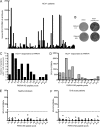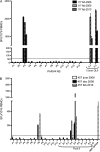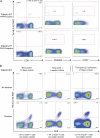High frequency, sustained T cell responses to PARV4 suggest viral persistence in vivo
- PMID: 21502079
- PMCID: PMC3080894
- DOI: 10.1093/infdis/jir036
High frequency, sustained T cell responses to PARV4 suggest viral persistence in vivo
Abstract
Background: Parvovirus 4 (PARV4) is a recently identified human virus that has been found in livers of patients infected with hepatitis C virus (HCV) and in bone marrow of individuals infected with human immunodeficiency virus (HIV). T cells are important in controlling viruses but may also contribute to disease pathogenesis. The interaction of PARV4 with the cellular immune system has not been described. Consequently, we investigated whether T cell responses to PARV4 could be detected in individuals exposed to blood-borne viruses.
Methods: Interferon γ (IFN-γ) enzyme-linked immunospot assay, intracellular cytokine staining, and a tetrameric HLA-A*0201-peptide complex were used to define the lymphocyte populations responding to PARV4 NS peptides in 88 HCV-positive and 13 HIV-positive individuals. Antibody responses were tested using a recently developed PARV4 enzyme-linked immunosorbent assay.
Results: High-frequency T cell responses against multiple PARV4 NS peptides and antibodies were observed in 26% of individuals. Typical responses to the NS pools were >1000 spot-forming units per million peripheral blood mononuclear cells.
Conclusions: PARV4 infection is common in individuals exposed to blood-borne viruses and elicits strong T cell responses, a feature typically associated with persistent, contained infections such as cytomegalovirus. Persistence of PARV4 viral antigen in tissue in HCV-positive and HIV-positive individuals and/or the associated activated antiviral T cell response may contribute to disease pathogenesis.
Figures





References
-
- Brown KE. The expanding range of parvoviruses which infect humans. Rev Med Virol. 2010;20:231–44. - PubMed
-
- Schneider B, Fryer JF, Reber U, et al. Persistence of novel human parvovirus PARV4 in liver tissue of adults. J Med Virol. 2008;80:345–51. - PubMed
-
- Longhi E, Bestetti G, Acquaviva V, et al. Human parvovirus 4 in the bone marrow of Italian patients with AIDS. AIDS. 2007;21:1481–3. - PubMed
Publication types
MeSH terms
Substances
Grants and funding
LinkOut - more resources
Full Text Sources
Research Materials
Miscellaneous

